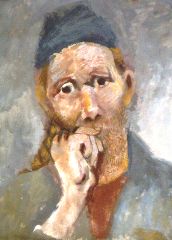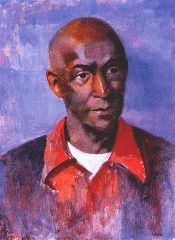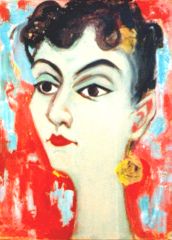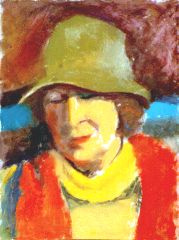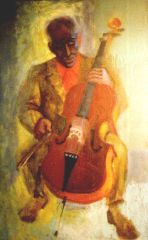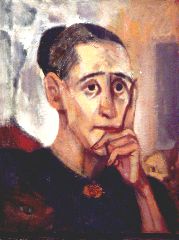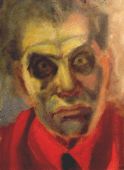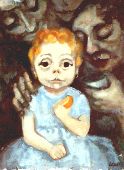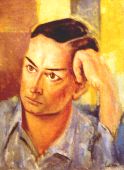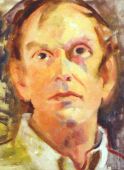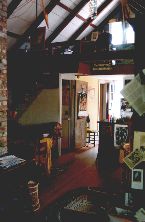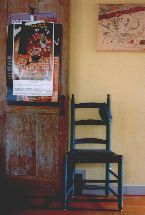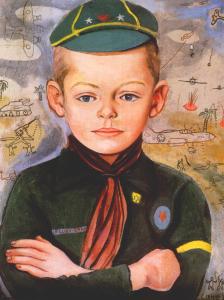|
A Remembrance of Betty Lane |
|
By Robert Finch |
|
When I think of Betty, what I seem to recall most is her figure, her body, small and frail, but distinctly hers. She was one of those people with an instantly recognizable gait and posture, even at a distance. I remember one time when she joined a group of us for a trip to Monomoy Island. As was her wont, she went off by herself, and I realized that, even at a distance of several hundred yards, her tiny, hunched frame – always leaning forward, her thin legs moving with short, quick steps, like a sandpiper – was unmistakable. I was Betty Lane’s friend and neighbor when, for nearly 20 years, we both lived near the corner of Stony Brook and Red Top Roads in West Brewster. Betty was one of an older generation of painters, sculptors, writers, and other artists who came to live in Brewster in the 1930s and 1940s, a group that included Conrad Aiken, Mary Aiken, Howard Gibbs, Eugene Fitsch, Tom Bouchard, and the young John Hay. “Arty types” were still looked upon with suspicion by many of the old Cape Codders in those days, and the presence of so many of them in West Brewster probably helped to preserve its local name of “Punkhorn,” with its connotation of strange or eccentric characters. Betty, who had supported herself as an artist and teacher for several decades, was a rich repository of bohemian lore about her local colleagues. Though they all knew one another and shared a life in art, it was not a particularly close group, or even always friendly. Conrad Aiken, who died the year before I moved to West Brewster in 1974, was clearly the dominant personality of the group. His drinking parties were legendary, as were his lecherous tendencies. As Betty once put it, “A woman wasn’t safe in the same room with Conrad.” Sometimes tiffs and occasional feuds arose from artistic differences or perceived rivalries, sometimes from more personal and trivial causes – all of which goes to show, I suppose, that artists are as human as anyone. Still, her stories painted a tapestry of fascinating personalities and rich artistic ferment in our little town. |
||||||||||||||||||||||||||||||||||
|
||||||||||||||||||||||||||||||||||
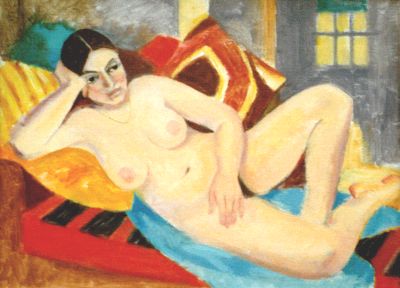 |
||||||||||||||||||||||||||||||||||
|
||||||||||||||||||||||||||||||||||
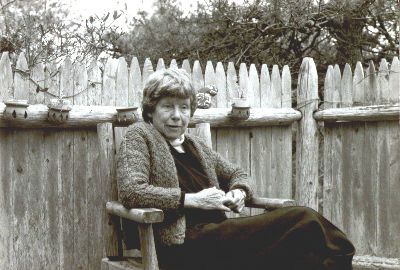 |
||||||||||||||||||||||||||||||||||
|
One of the idiosyncrasies of the house, given its recent construction, was its lack of washer or dryer. A friend of Betty’s once explained to me that “she had her thrifty ways and didn’t believe in owning large appliances;” so for thirty years she did her own wash in the basement sink or went to the local laundromat. The basement was where Betty held her weekly art classes for many years and stored hundreds of her paintings and sketches. The art class, known as “the basement group,” used local models wherever Betty could find them. At one time or another all the members of our family – my wife, my son, my daughter, myself, and even our cat, posed for her. Once, when my daughter Katy was about four, Betty did an oil portrait of her from a sketch she made at our house. The portrait shows Katy sitting on our bedroom floor with the cat on the cedar chest behind her, as she stares mesmerized at something off to the side in front of her. Betty called it “Saturday Morning.” It is one of my favorite Betty Lane paintings, and I bartered her for it in exchange for cutting and delivering a half cord of firewood. Betty frequently passed my house when she walked up Dry Hill to visit her friend Kristi Hay. Over the years she had worn a path through the woods from her house that we always referred to as “Betty’s Path,” the way several other older paths in the neighborhood still carried the eponyms of vanished residents to whose vanished houses they once led, like “Aunt Thankful’s Path” and “Ikey Dunham’s Path.” Once a hurricane felled a large pitch pine across Betty’s path, and I chain sawed out a gap so she could continue to pass through. |
||||||||||||||||||||||||||||||||||
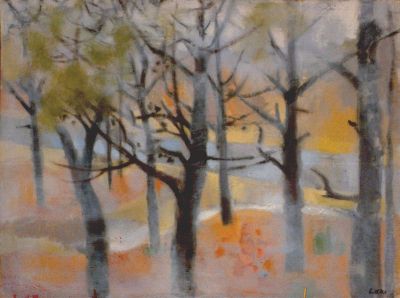 |
||||||||||||||||||||||||||||||||||
|
If I was outside when she walked by, she would usually stop for a few words. I always relished these brief visits with Betty, for she seemed to have a congenital inability to make commonplace remarks. Like many visual artists I have known, she thought non-linearly, not only about art but about most things, making unexpected leaps and connections in discussing the most ordinary matters. She had a dry, candid and occasional sharp wit. She once told me that her mother “was a natural musician, but she was considered ‘too delicate’ to perform, so she had six children instead.” Though she herself only had one child, Betty seemed to have a natural empathy and ease with children. Unlike most adults, she treated them and their concerns seriously. As a single, independent woman artist who managed to support herself, she was something of a role model to adolescent girls. More than one in the neighborhood sought her out over the years as a confidante.
|
||||||||||||||||||||||||||||||||||
|
Once she showed me a veritable gallery of portraits, spanning several decades, stored in her basement – mostly of local people and artists she had known. Some of these, especially the adults, are unsparing, dark and powerful images. These portraits struck me as a memorable record of a neighborhood, and a community, over time. Yet she had never exhibited many of them, saying that, although most of the subjects were now dead, there were still family members around who might be offended. Betty was impatient with dull people, and dull questions. Once I went to her deliberately as a resource on art. I was writing an essay about flowers in our garden and wanted the name of the exact shade of color of our marigolds. She seemed slightly irritated at the questions, as if puzzled why names should matter. “I don’t know,” she said. “Yellow? Orange?” But if Betty could sometimes be impatient with dullness or incompetence in others, she was even less tolerant with herself, even in her pleasures. Next to art, music was her great love. Among her many talents Betty was an accomplished viola player, and for many years she played chamber music with her great friend, the cellist Herbert Pierce. For a few years, when she was already in her 70s, I had the pleasure of occasionally playing chamber music with them at my house. But one day she informed me that she was selling her viola. “Why?” I asked. “I’m not good enough,” she replied. “I’ve stopped pleasing myself.” After Betty’s stroke during the summer of 1993, I housesat for her for several months over the following winter. During that time, I had the opportunity to peruse, at leisure, some four decades of work that she had stored in her basement, covering more than forty years. There were, in addition to those I knew, many of her more recent paintings, including portraits of her grandchildren, Marti, Megan and Christopher, as well as others of my own children which I had never seen. These hundreds of paintings and sketches reflected a bewildering variety of subjects and styles – figures, landscapes, animals – so different they might have come from the hand of several different artists, yet, like her own small form, imbued with Betty’s unmistakable touch. |
||||||||||||||||||||||||||||||||||
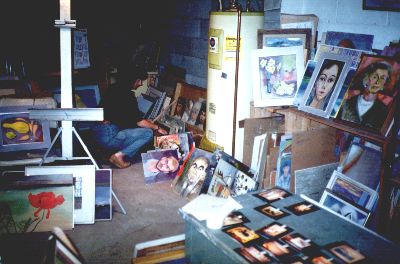 |
||||||||||||||||||||||||||||||||||
|
What struck me the most was how her technique, approach and vision continued to evolve throughout her working life. Just as, in her everyday conversation, she always had a fresh take on the world, so in her art she never continued to produce a type of work simply because she could do it well, but seemed always to be seeking a newer and better language to express her evolving vision of people and the world. I use the word “language” significantly here, for the most surprising revelation I discovered about Betty during my stay in her house was not her paintings, but her words. Inside a small table placed next to the chimney there were a dozen or more journals, most in inexpensive spiral notebooks, which she kept consistently throughout most of her adult life. Many of these seemed to be accounts of trips she took with student groups to Europe when she was teaching at the old Sea Pines School in Brewster, or personal trips to Mexico and other places. The one that most caught my eye, though, was the earliest, a cloth-bound journal, written in 1936, when she and Gerald were living in an unelectrified cottage in Kent, England. With Nick’s permission I read it and found it to be a remarkable document, on many levels. Much of it presents a portrait of a group of young, poor, expatriate artists living in Europe – writers like Conrad Aiken, Malcolm Lowry and Jacob Bronowski, filmmakers and painters including Basil Wright and Humphrey Jennings and others. Many of the longer passages read as a superb comedy of manners, depicting the interaction of egotistical, often conflicting personalities, done with a wit, an ear for dialogue, and an eye for character and scene that Jane Austin would have been proud of. Betty could sketch a personality deftly, forcibly (and sometimes mercilessly) with a few words as impressively as she could a face in one of her drawings. Such passages create a fascinating evocation of a particular time and place, recorded by a perceptive and sensitive intelligence with a seemingly prescient awareness of the ominous rumbles of the coming conflagration in Europe. The journal is full of unusual responsiveness and empathy for the physical world and a clear understanding of herself, utterly without sentimentality, yet full of sentiment, and always with that unexpected, unconventional, yet precise and revealing use of language that was so characteristic of Betty, in both her speech and writing, as in the following excerpt:
The journal is also a testament of her dedication of herself to a life in art at a time she received little encouragement, even from those close to her – of spending a last few dollars for trips to the Prado in Spain, for instance, where she would spend hours sitting before a Delacroix or an El Greco or a Goya, not sketching, simply seeing. Later, when I visited her in the convalescent home, I brought one of her books on the Prado, and as we looked through it, she would often stop at a painting that she had known there. Of Velasquez she would say, “I wore out the bench on that one.” She loved Goya perhaps best of all and more than once would stop me at one of his paintings to say, “I made a life on that one.” Once I commented to her that it must have been hard in those days, with so little money, to choose a life in art. “Oh no,” she said, “it was easy. For me there was never any choice.” Yet one of the surprises of the 1936 journal is the discovery that, at age 29, Betty was still seriously debating whether she wanted to be a painter or a writer. The instinct and talent for both seems to have always been there, and to have remained throughout her life. She once told me, “ I never did anything without writing about it.” But she seems to have understood intuitively that one could not serve two artistic masters and achieve genuine excellence, and so she chose painting. Given the dimension of her achievement as an artist, one can hardly regret the choice she made, but the journals give ample evidence that it could not have been a simple or obvious choice, and that, had she chosen differently, the world might have had the work of the remarkable writer she could have been instead of the work of the remarkable artist she was. |
| Home | About Betty Lane | Making a Life in Art | Remembering Betty |
